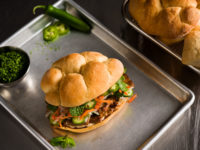State of the Industry 2019: Diversifying buns and rolls for maximum growth
The mature buns and rolls segment can find growth through alignment with health concerns and ethnic culinary trends




While a core aspect of the buns and rolls market is still to serve as unassuming, predictable carriers for everyday sandwiches and backyard barbecues, the category has room for growth, and differentiation is the name of the game.
Overview | Bread | Tortillas | Sweet Goods | Snack Cakes | Pizza | Desserts | Cookies | Buns & Rolls | Bars | Breakfast Products
Market data
The data from IRI, Chicago for the 52 weeks ending March 24, 2019 paints a relatively flat year for buns and rolls. Hamburger and hot dog buns dropped 2.2 percent to $2.1 billion, but the encompassing “all other” fresh rolls/buns/croissants segment grew 1.5 percent to $2.0 billion.
Private label maintains a strong lead in hamburger and hot dog buns, but dipped 1.9 percent to $775.2 million for the year. Bright spots include 9.1 percent growth for Campbell Soup Co. and its Pepperidge Farm brand, climbing to $139.5 million. United States Bakery also saw nice growth, up 7.8 percent to $40.4 million. King’s Hawaiian Bakery West recovered some ground this year, up 11.7 percent to $29.8 million after seeing a 12.0 percent drop as noted in our 2018 coverage.
In the all other fresh rolls/buns/croissants segment, private label likewise took a loss, dropping 2.4 percent to $529.8 million. In this market, competition runs closer, and King’s Hawaiian closed the gap somewhat, up 4.4 percent to $503.2 million. But the big news in this segment is the addition of Carrs Food International and its St Pierre brand to the top 10.
Looking back
England-based Carrs Food International has significantly ramped up a U.S. distribution program for its St Pierre brand, including croissants and a wide-ranging assortment of brioche products, regularly merchandised in the in-store bakery. Recent product releases have included Brioche Popovers, Butter Croissants and Chocolate Croissants.
European staples continue to make inroads to the U.S. buns and rolls market. For example, Bridor has released artisan—yet accessible—sourdough products like its new White Ciabatta Artisan Soft and Multigrain Ciabatta Artisan Soft varieties.
“Consumers are seeking better-for-you options in everyday foods and indulgences alike, and manufacturers are responding by supplying more choices to meet individual nutrition needs in all foods,” says Don Trouba, senior director, go-to-market, The Annex by Ardent Mills, Denver. “In bakery applications, including buns and rolls, we’re seeing greater interest in ingredients with higher fiber content for increased energy, feeling fuller for longer and other dietary and nutritional benefits. We’re also continuing to see global influences emerge in bakery applications—especially sandwich rolls.”
Looking forward
Consumers are growing more engaged, and that includes a desire for transparency. “We’ve identified a macro-trend we’re calling ‘The Wholesome Story’ that shows consumers ascribing deeper meaning and connection to the foods they eat,” says Trouba. “Consumers are looking beyond traditional label information for more details about the stories behind the foods they eat.”
This equates to better supply-chain transparency, and an associated rise in the natural and organic sector. “Stories of growers, unique varietals, thoughtful harvesting, flavorful preparation techniques and other details lend richness, quality and a sense of craft to everyday menu staples,” says Trouba. “Following this trend, heirloom wheats such as triticale (a hybrid of wheat and rye) and spelt allow consumers to try different wheat varieties they haven’t experienced before.”
Trouba also notes that White Sonora, an heirloom wheat, has a unique character and a story to tell, with its origins dating back to the 1700s in Mexico.
“While finding something new and unique is important to bakers and manufacturers, cost and available supplies are always top considerations,” says Tim Howdeshell, product development scientist, R&D, Ardent Mills. These options could include ancient grains like quinoa, teff, amaranth and sorghum, which add stronger, more-pronounced flavors. “Our heirloom grains such as White Sonora typically have longer fermentation times, which deliver distinct flavors.”
Bakers will sometimes need to made adjustments when working with different grains. “In terms of streamlined production, an important consideration is machinability and functionality of the flours,” says Howdeshell. “Certain wheat varieties like spelt have high mixing tolerances and a highly functional gluten, whereas other flour additions may require adding additional gluten to support the dough structure.
Ancient grains often lack functional gluten, and depending on product type and inclusion levels, extra care might be needed to support the dough structure.
Overview | Bread | Tortillas | Sweet Goods | Snack Cakes | Pizza | Desserts | Cookies | Buns & Rolls | Bars | Breakfast Products
Looking for a reprint of this article?
From high-res PDFs to custom plaques, order your copy today!








